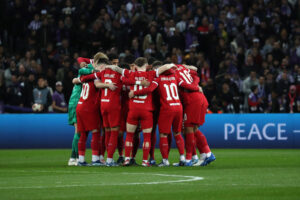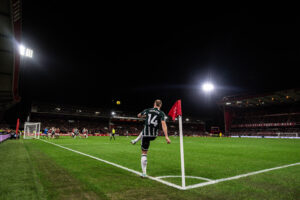After two years of construction and a cost of €200 million euros, the Stadio delle Alpi opened its doors on May 31 1990 to give a new home to Turin’s two clubs of Juventus and Torino. The Stadio delle Alpi held a celebratory match consisting of both the Turin based-clubs. They united together to form one team again Porto, with the twin Turin team winning 4-3.
With that, the stadium was ready for business and on the horizon was the showpiece Italia 90 World Cup.
Stadio delle Alpi: Never to be Forgotten Football Grounds
The World Cup Legacy
The Stadio delle Alpi was one of the venues used for the 1990 World Cup. The stadium averaged attendances around 60,000 and hosted five matches in total. Highlights included the semi-final between England and West Germany, which West Germany won 4-3 on penalties.
A Frosty Alpine Atmosphere
The stadium’s original capacity was 69,041 and included an athletics track which surrounded the pitch, as the Turin authorities wanted a multi-purpose stadium.
That decision backfired, with the ground producing poor acoustics and supporters were too far away from the action. Add to that the grey and bland colour scheme and it made for a cold matchday atmosphere.
Matches at the Stadio delle Alpi were very rarely sold out, even for Juventus’ most important Champions League matches. Naturally, supporters took a quick dislike to their new surroundings. The general feeling was one of a cold experience in all parts of the stadium. This was the case in the noisy singing stand of Curva Sud. Even the press box was not up to the standard required.
The poor stadium design meant that there were significantly poor sightlines and viewing restrictions in many seating positions, especially during the wintertime with the stadium open to the brutal elements of the Alps (hence the name ‘Stadium of the Alps’).
The stadium gave a nod to its mountainous neighbour with the erection of two massive mountain-shaped structures to signify the Alps.
Ballon d’Or Presentation
In the pre-match festivities between Juventus and Perugia on January 6 2004, Czech Republic midfielder Pavel Nedvěd received his Ballon d’Or trophy. The classy attacker beat Andriy Shevchenko and David Beckham to the much-coveted prize.
In a match with severe snowy conditions, Nedvěd scored the winning goal in that game with a thumping long-range strike and gave the Stadio delle Alpi a rare moment of joy.
Stadium Milestones
Although attendance figures suffered during the winter months, towards the business end of the season the Juventus supporters flocked to the ground. Usually, they would see their team regularly in the hunt for domestic and European honours.
The attendance record occurred on 14th May 2003 when Juventus took on Real Madrid in the Champions League. A record 73,583 supporters were in attendance at the semi-final tie.
Contrast that with the lowest attendance record in the 2002/03 season when Juventus hosted Sampdoria in the Coppa Italia – just 237 fans witnessed the Stadio delle Alpi nadir.
Stadium Sharing
The subject of rival clubs sharing grounds is always the topic of debate. Inter and AC Milan both do it and between 1990 and 2006, Juventus and Torino were footballing neighbours too. Over time, and as both sets of supporters continued to criticize the stadium, the attendance figures dwindled.
During the 90s, Juventus attracted an average attendance of mid-40,000. However, by the end the Stadio delle Alpi era, only 25,000 were coming to the matches. It was similar with Torino, who originally attracted mid-30,000, but by the end of its time, only around 15,000 attended.
Financial Burdens
The stadium was budgeted to host high profile athletics events but they were few and far between. Couple that to the fact that maintenance fees were much higher than projected, numbers meant that the Stadio delle Alpi haemorrhaged a significant amount of money. That only added to the doom and gloom of its popularity, or rather lack of it.
The End of an Era
Much to the delight of many, the stadium played host to its final game on 11th June 2006 with a Serie B play-off final match between Torino and Mantova for a place in Serie A.
Juventus, along with Torino, moved into the brand new Stadio Olimpico in 2006, a stopgap in wait for their new Stadio delle Alpi to open. Torino purchased their old stadium, the Stadio Comunale, and after refurbishment for the 2006 Winter Olympics, it became the Stadio Olimpico in its honour.
No tears were shed as the Stadio delle Alpi became rubble soon after. The demolition finished in February 2009 and it had a short and fleeting existence of just 16 years.
The Aftermath
In the place of the unloved Stadio delle Alpi was the redeveloped Juventus Arena, which stands on the same area. It opened on September 8 2011 and Juventus became the first major club to downsize their stadium with the new arena accommodating 41,507 spectators. The new stadium has no running track and it has better viewing areas and upgraded facilities fit for the modern era. All in all, it is a stadium at the cutting edge of technology.
Much like its mountain range which towered above it, the Stadio delle Alpi had some rocky moments throughout its time. However, it does have its place in footballing history as a ground never to be forgotten; for the good, the bad and the ugly.
Main Photo






